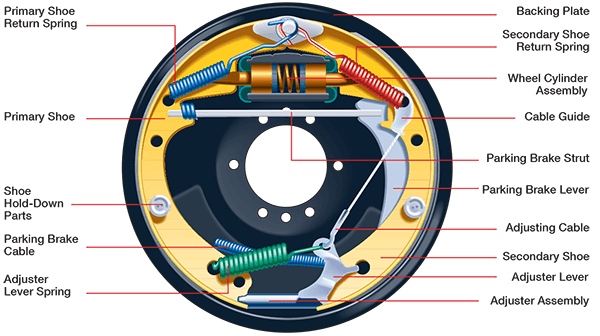If someone ask you a question that can you drive your vehicle without brakes? Then what will be your answer, obviously No. Driving a vehicle without brakes is impossible. Brakes are crucial for stopping a vehicle and driving safely on the road. The use of a proper braking system enhances the handling of the vehicle to a greater extent. In modern vehicle, the drum brakes are mostly installed at rear wheels. There are different types of brakes available in the market. But here I will discuss only about Drum brakes and how it works.
To understand this brake in detail first we must have a keen knowledge of its various parts and their function.
Main Parts of Drum Brakes

Image Source
The whole assembly of the drum brake is fitted to the back plate of the wheel. The back plate remains stationary and it does not rotate with the wheel.
1. Brake Drum:
It is a round cast iron housing which is used to stop the vehicle with the help of brake shoe. The drum brake is bolted to the hub of the wheel. It rotates with the hub.
2. Brake Shoe:
It is the frictional part of the drum brake, without it the working of the brake is not possible. The brake shoe has brake lining at its outer curve. It is the brake lining which makes contact with brake drum during the stopping of the vehicle. It is of two types
(i) Primary Brake Shoe: The shoe having large lining material is called as primary shoe.
(ii) Secondary brake shoe: The shoe with small lining material is called secondary shoe.
3. Wheel Cylinder:
It is used to force the brake shoe outward to apply the brake. The wheel cylinder is connected to the master cylinder. It contains piston which moves outward when brake is applied and forces the brake shoe towards inner surface of the drum.
4. Return or Retracting Spring:
It is used to retract the brake shoe after brake is applied. Two return springs are there in durm brake, one for the primary shoe and other one is for secondary shoe.
5. Self Adjuster:
It maintain the minimum gap between the brake shoe and drum so that they do not contact each other when pedal is not pressed. In the case if the brake lining wear out, and gap increases in between the shoe and drum, It can be adjusted again to maintain the gap between shoe and drum inner surface. once it is adjusted it maintains the same gab during the brake working by itself.
Also Read:
- How Anti-lock Braking System (ABS) Works?
- How DTSi Engine Works – Explained?
- Drum Brakes vs Disc Brakes – Which is Better?
Working Principle
The brake shoe is allowed to expand in both the directions. As the brake lining of the shoe touches the inner surface of the drum, friction is generated in between the brake shoe and drum and stops the vehicle from moving.
Working of Drum Brakes
- As the brake pedal is pressed, it compresses the fluid in the master cylinder and allows the piston of the wheel cylinder to expand outward.
- The outward motion of the piston of the wheel cylinder forces the brake shoe outward against the brake drum.
- As the brake shoe lining touches the inner surface of the drum, and due to the friction generated in between the brake shoe and drum, the motion of the wheel reduces and vehicle stops.
- As the force is removed from the brake pedal, the retracting springs draw the brake shoe inward and the contact between the friction lining and drum ended. Now again the brake is ready to apply.
- A self-adjusting screw is present at the bottom, which is used to maintain a minimum gap between the drum and brake shoe. When the lining of the brake shoe is wear out than the gap between the drum and brake shoe increases, at that time the adjuster is adjusted again to maintain the minimum gap.
For a better explanation of how drum brakes work watch the video given below:
Advantages
- They are self-energizing braking systems. It means they are designed to operate by itself.
- It is cheaper than the disc braking system.
Disadvantages
1. Heating problem: Since the friction area is totally covered by lining, so heat is developed during the friction is not allowed to go out in the atmosphere. This may reduce the braking efficiency of the vehicle.
2. The drum brakes will not work properly if it gets wet in water. This is because water takes a longer time to come out from the drum. the water reduces the friction in between the brake lining and the drum.
Conclusion
In this article, we have learned about how drum brakes work and its main parts, working principle, advantages, and disadvantages. I hope you have understood it clearly and if you found this piece of information useful and valuable then don’t forget to like and share it.
